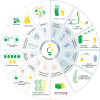Sex as a biological variable in ageing: insights and perspectives on the molecular and cellular hallmarks
- PMID: 39471841
- PMCID: PMC11521605
- DOI: 10.1098/rsob.240177
Sex as a biological variable in ageing: insights and perspectives on the molecular and cellular hallmarks
Abstract
Sex-specific differences in lifespan and ageing are observed in various species. In humans, women generally live longer but are frailer and suffer from different age-related diseases compared to men. The hallmarks of ageing, such as genomic instability, telomere attrition or loss of proteostasis, exhibit sex-specific patterns. Sex chromosomes and sex hormones, as well as the epigenetic regulation of the inactive X chromosome, have been shown to affect lifespan and age-related diseases. Here we review the current knowledge on the biological basis of sex-biased ageing. While our review is focused on humans, we also discuss examples of model organisms such as the mouse, fruit fly or the killifish. Understanding these molecular differences is crucial as the elderly population is expected to double worldwide by 2050, making sex-specific approaches in the diagnosis, treatment, therapeutic development and prevention of age-related diseases a pressing need.
Keywords: X chromosome; X-chromosome inactivation; ageing; hallmarks of ageing; sex chromosomes; sex hormones.
Conflict of interest statement
We declare we have no competing interests.
Figures


Similar articles
-
New hallmarks of ageing: a 2022 Copenhagen ageing meeting summary.Aging (Albany NY). 2022 Aug 29;14(16):6829-6839. doi: 10.18632/aging.204248. Epub 2022 Aug 29. Aging (Albany NY). 2022. PMID: 36040386 Free PMC article.
-
Molecular and biological hallmarks of ageing.Br J Surg. 2016 Jan;103(2):e29-46. doi: 10.1002/bjs.10053. Br J Surg. 2016. PMID: 26771470 Review.
-
The influence of sex-specific factors on biological transformations and health outcomes in aging processes.Biogerontology. 2024 Oct;25(5):775-791. doi: 10.1007/s10522-024-10121-x. Epub 2024 Jul 13. Biogerontology. 2024. PMID: 39001953 Free PMC article. Review.
-
Sex differences in biological aging with a focus on human studies.Elife. 2021 May 13;10:e63425. doi: 10.7554/eLife.63425. Elife. 2021. PMID: 33982659 Free PMC article. Review.
-
Epigenetic developmental mechanisms underlying sex differences in cancer.J Clin Invest. 2024 Jul 1;134(13):e180071. doi: 10.1172/JCI180071. J Clin Invest. 2024. PMID: 38949020 Free PMC article. Review.
Cited by
-
Gender differences in advanced activities of daily living: evidence from the longitudinal study of health and aging in Mexico 2012-2018.Front Aging. 2025 Jul 28;6:1544493. doi: 10.3389/fragi.2025.1544493. eCollection 2025. Front Aging. 2025. PMID: 40791243 Free PMC article.
References
Publication types
MeSH terms
Substances
Grants and funding
LinkOut - more resources
Full Text Sources
Medical

